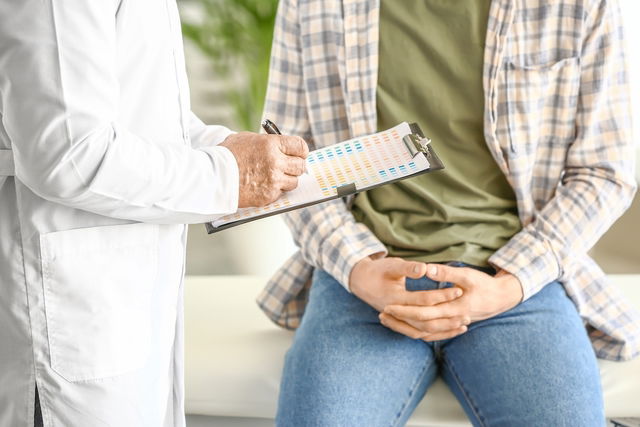Male yeast infections are characterized by the excessive growth of Candida fungus in and around the penis. It can cause symptoms like local redness, mild swelling and itching. Candida fungus is naturally present in men and women’s genital areas, however some changes can lead to overgrowth of these cells. Changes in the immune system, for example, can lead to the emergence of yeast infections.
While yeast infections are more common in women, they can appear in men, particularly in those with poor hygiene habits. In addition to the genital area, men can experience fungal infections in other areas of the body, like between the toes, in the groin and inside the mouth.
Yeast infections are easily treated when adequate treatment is followed. Usually they are treated with topical ointments applied directly on affected areas, or with oral antifungals. Treatment does not guaranty immunity, however, and men should maintain adequate hygiene to prevent reemergence. Genital yeast infections also require treatment by any sexual partners to prevent reinfection from sex.

Main symptoms
The main symptoms of a yeast infection in men are:
- Pain, burning, swelling and local redness in the glans or foreskin
- Intense itching in the area
- Reddish and/or whitish plaques on the penis
- Whitish or transparent secretion that covers the reddish regions
- Pain, discomfort or burning sensation when urinating
- Dryness of the skin
- Difficulty exposing the glans
Furthermore, in some cases, sores may appear on the penis, and many men may report increased sensitivity, foul odor and general discomfort.
In addition to appearing on the penis, a yeast infection can also appear on the testicles or affect the groin, and other places on the body, such as between the toes and inside the mouth.
Common causes
Yeast infections can be caused by a number of factors, but changes in the immune system seem to favor the overgrowth of fungal cells in the genitals, mouth and skin. Many common causes of yeast infections are:
- Recent cold of flu viruses
- Stressful periods
- Having sex without using a condom;
- Frequent or prolonged use of antibiotics, corticosteroids or antidepressants;
- Chronic disease, like diabetes;
- Poor genital hygiene;
- Diseases that weaken the immune system, such as AIDS or lupus;
- Undergoing chemotherapy
- A diet rich in sugary foods.
There are certain situations that also favor the proliferation of fungal cells, like using overly tight clothing and sedentary lifestyles. It is important to remember that yeast infections can also affect the mouth, throat, nails, skin and scalp. Learn how yeast infections can affect women differently.
Online symptom checker
To find out your risk for having a yeast infection, report your symptoms below:
This symptom chcker is only a guidance tool and does not serve as a diagnosis or replace a consultation with a doctor.
Confirming a diagnosis
The diagnosis of a male yeast infection is confirmed by a urologist through a assessment of the patient's symptoms and health history, as well as a physical examination. In recurrent or atypical cases, laboratory tests may be ordered to confirm the presence and species of the fungus.
Yeast infections that do not specifically affect the genital region can be evaluated by a dermatologist or general practitioner, who will recommend the most appropriate treatment.
Treatment options
The treatment of male yeast infections should be monitored by urologist, who may prescribe:
1. Antifungal creams
Candidiasis ointments are antifungal ointments that work by inhibiting the growth of the Candida albicans fungus.
The treatment time with these ointments varies from 1 to 3 weeks. it is important not to interrupt treatment, even if symptoms improve within a few days. Learn more about yeast infection creams your doctor may prescribe and how to use them.
2. Corticosteroid ointments
Corticosteroid ointments, such as hydrocortisone, may be indicated in cases of more intense inflammation in the genital region, to help alleviate symptoms. These ointments are often used in combination with antifungal ointments.
3. Oral antifungals
In more serious cases, with more intense inflammation in the glans or foreskin, the urologist may also prescribe oral antifungals, which help eliminate Candida albicans.
4. Proper intimate hygiene
Adequate intimate hygiene is important during the treatment of male candidiasis, but is equally important to prevent new flare-ups. You should wash your penis by pulling the foreskin down, and always keep the penis clean and dry. You should| also avoid using products that can irritate the skin, as well as use a condom during sex.
5. Diet changes
Diet changes can help cure yeast infections faster. These involve reducing carbohydrate consumption and avoiding sweet foods and alcoholic beverages. Furthermore, you are advised to consume natural probiotic foods, such as yogurt and kefir, for example, fruits and vegetables and whole grains, for example, as they help to strengthen the immune system to fight infection.
Read more about the candida diet for yeast infections your doctor may recommend.
To complement medical treatment, a great home remedy option for candidiasis is ginger tea, for example. Check-out other home remedies for yeast infections that you can take to complement medical treatment.
How to prevent
It is common for yeast infections to reemerge after symptoms have seemingly improved. To prevent this from happening, it is important to:
- Follow an appropriate diet, rich in water, fruits and vegetables to strengthen the immune system;
- Avoid wearing warm, tight or wet clothing;
- Practice good hygiene of the genital area;
- Use condoms during any sexual contact.
Strengthening the immune system is also a great way to prevent the spread of Candida albicans, so you should eat less sugar, exercise, and follow a healthy diet.
